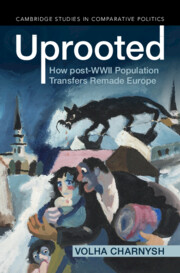Book contents
- Frontmatter
- Contents
- Figures
- Maps
- Tables
- Preface and Acknowledgments
- Abbreviations
- Part I Introduction
- Part II Social Cohesion and Public Goods
- 3 Cooperation in Homogeneous and Heterogeneous Polish Villages
- 4 Cooperation in West German Communities
- Part III State Building in the Wake of Displacement
- Part IV Long-Run Economic Consequences of Uprooting
- Appendix A Additional Maps, Figures, and Tables
- Appendix B Sources for Archival and Statistical Data
- References
- Index
- Cambridge Studies in Comparative Politics
3 - Cooperation in Homogeneous and Heterogeneous Polish Villages
from Part II - Social Cohesion and Public Goods
Published online by Cambridge University Press: 07 November 2024
- Frontmatter
- Contents
- Figures
- Maps
- Tables
- Preface and Acknowledgments
- Abbreviations
- Part I Introduction
- Part II Social Cohesion and Public Goods
- 3 Cooperation in Homogeneous and Heterogeneous Polish Villages
- 4 Cooperation in West German Communities
- Part III State Building in the Wake of Displacement
- Part IV Long-Run Economic Consequences of Uprooting
- Appendix A Additional Maps, Figures, and Tables
- Appendix B Sources for Archival and Statistical Data
- References
- Index
- Cambridge Studies in Comparative Politics
Summary
This chapter explores the relationship between natives and migrants in the territory transferred from Germany to Poland in 1945 using contemporaries’ memoirs. It shows that migration status and region of origin served as salient identity markers, structuring interpersonal relations and shaping collective action in the newly formed communities. Statistical analysis is used to demonstrate that indigenous villages and villages populated by a more homogeneous migrant population were more successful in organizing volunteer fire brigades than villages populated by migrants from different regions.
Keywords
- Type
- Chapter
- Information
- UprootedHow post-WWII Population Transfers Remade Europe, pp. 65 - 88Publisher: Cambridge University PressPrint publication year: 2024

